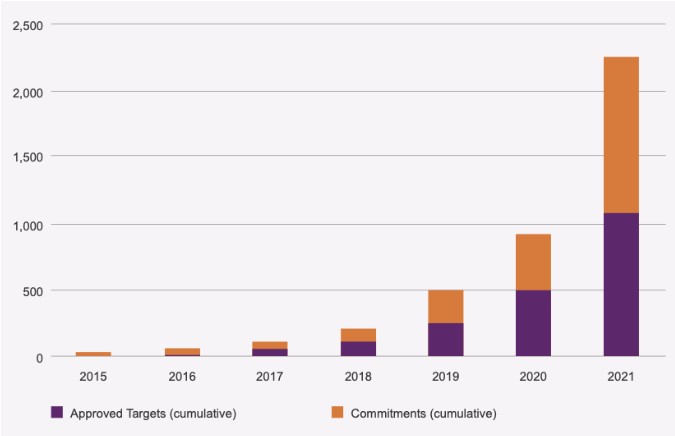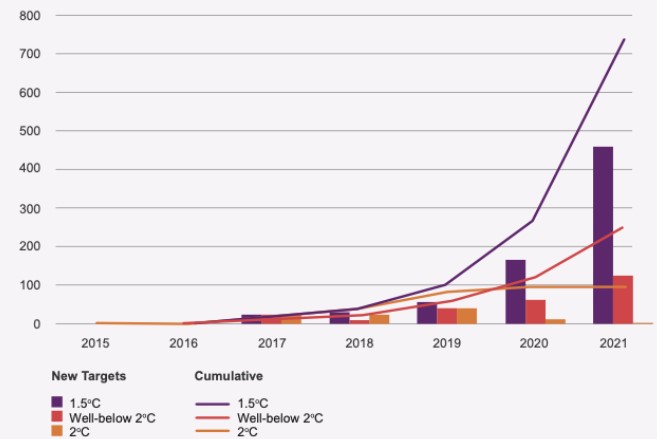
A record number of companies are committing to and setting science-based greenhouse gas emissions reduction targets, according to research from the Science-Based Targets initiative (SBTi). The SBTi’s third assessment of the initiative’s impact since its launch in 2015, shows that in 2021 companies registered with SBTi represented over a third of global market capitalisation, worth some $38 trillion, which is an increase of 20% from 2020.
A global collaboration between CDP, the United Nations Global Compact, World Resources Institute (WRI), the World Wide Fund for Nature (WWF), and one of the We Mean Business Coalition commitments, the SBTi has as its mission to accelerate companies across the world in supporting the global economy to halve greenhouse gas emissions before 2030 and achieve net zero before 2050.
According to its third assessment report, entitled ‘Scaling urgent corporate climate action worldwide’, the total number of companies under the SBTi doubled last year to 2,253, which includes 1,082 firms with approved emissions reduction targets and another 1,171 that are committed to setting science-based targets (SBTs). They are based in 70 countries and represent a total of 15 industry sectors. Significantly, the cohort includes 117 financial institutions. In the first quarter of 2022 another 500 companies have set or committed to targets.
Dr Luiz Fernando do Amaral, CEO of the SBTi, said that this period, when the world is facing a number of existential crises, is the time to come together for the greater good. "The science is clear," he said. "We are already experiencing the impacts of climate change, and continuing on the current trajectory equals catastrophe. This report shows that the value the SBTi brings to society is more needed now than ever before – we must continue to drive the exponential growth of science-based targets and make them ‘business as usual’ for companies and financial institutions worldwide."
Environment Analyst caught up with Brazil-based Dr Amaral, who was appointed as the first chief executive of SBTi in February, to get his perspectives on the milestones achieved to date and the systemic challenges ahead.
Milestones, tipping points and credibility gaps
According to SBTi’s CEO, three major accomplishments stand out. The first is the sheer size of the movement, "with one-third of the global economy now committed [under the SBTi], so it’s no longer just a few leaders or a niche part of the corporate sector".
The second, he explained, is that a "critical mass of what we classify as high-impact companies" (some 27%) have now joined the initiative.
"Our theory of change is that when you start to reach 20-25% within a sector then you reach a tipping point to move to the middle of the curve belt, from the early adopters to the greater majority [i.e. mass adoption]," said Amaral.
The third milestone – and the one he is most excited about – is that the research finds that SBTi companies are reducing emissions at an accelerated pace compared to the wider economy. In 2020, for example, the cohort exceeded global trends and collectively achieved a 12% reduction in scope 1 and 2 emissions, compared to the 5% overall global emissions reduction due to COVID-19. "It’s a fantastic indication of the direction of travel and success of this work, although there is still more to be done in terms of improving our monitoring and reporting systems," Amaral added.
To this end, SBTi is launching its ‘Progress framework’, a platform designed to provide a standardised mechanism to track organisations’ progress against their SBTs, in early 2023. Thus measurement, reporting and verification (MRV) framework aims to build on the SBTi’s annual progress reports and deliver increased transparency and accountability on how firms are delivering on their ambitions, thereby closing the credibility and reporting gap, as elucidated in the report.
"Carbon accounting and carbon disclosure – key to facilitating the process of target setting and progress monitoring – will need to ramp up hugely"
SBTi has also introduced the Net Zero Standard, the aim of which is to help embed the urgency for action through nearer term target setting, as well as defining what a credible, long-term net-zero target entails, including the role of ‘beyond value chain mitigation’ (BVCM). The standard, which was launched to coincide with COP26 last year, also introduces more stringent rules where the more challenging scope 3 emissions are concerned.
"One of the major issues for us moving forward is to be able to assess if the ambition meets the science and if the ambition is being delivered on, so we need to improve the systems of disclosure and monitoring. The disclosure systems for public companies form another area that has been building steam in the last few months. So carbon accounting and carbon disclosure – key to facilitating the process of target setting and progress monitoring – will need to ramp up hugely," said Amaral, whose observations will come as good news for providers of these services.
Amaral went on to positively endorse the role of consultants as key actors in the climate impact "ambition loop", as identified in the report, commenting: "There is a value chain around the pre- targets setting and strategy stage, as well as in helping to make companies ready on accounting, making their data ready for reporting and target setting. Then the implementation phase, where consultants also provide support, is extremely important work. They directly impact on the system through the ultimate reduction of emissions of the companies they are advising."
Geographic and sectoral inequalities
Another area SBTi is looking to improve is the diversity of committed companies – in terms of their size, geography and industry. A high proportion of the targets come from firms based in Europe, North America and Japan, with relatively few from Asia, Africa and Latin America (although the regional distribution is reflective of where the lion’s share of GDP and emissions originate). At the same time, generally lighter-emitting SMEs and, at the other end of the spectrum, the heavy-emitting industries "continue to be under-represented", according to the progress report.
"We need to start to grow more among the second tier of companies, and bring in more small and medium-sized firms at scale," Amaral explained. "Furthermore, we hope that the sector-specific technical guidance the SBTi is currently working on will help bring in more of the heavy emitters across industries such as cement, chemicals, oil & gas, and food & agriculture."
Figure 1: A record year for new approved targets and commitments — annual cumulative number of companies with approved targets and commitments 2015-2021 (Source: SBTi progress report)

Figure 2: Increasing momentum for 1.5°C — temperature alignment and growth of scope 1 and 2 targets, 2015-2021 (Source: SBTi progress report)

